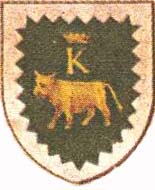History
Knights (Cavaliere) of the House of Bove traveled north to Germany, where they lead many armed forces with the House of Grisone. Count Carl of Anjou, later titled King Charles I of Naples requested their support against King Conradin of Sicily.
In the 13th century King Charles I of Naples ennobled Sergio Bove of the House of Bove with title and feudal territories in Bitonto. Sergio Bove's title allowed him to administer trade and commerce in his feudal territories.
November 1, 1419 the House of Bove received partial exoneration of taxes from Queen Joan II of Naples, Kingdom of Naples.
Coat of Arms: a golden ox with a golden letter K,
topped with a royal crown, enclosed in a silver patterned border.
Notable marriages with other families of the Nobility of Italy
Giovanna Bove, daughter of Giovanni Battista Bove, Patrician of Ravello, and Imperia Caracciolo] married Giovanni Battista Brancia, Patrician of Sorrento, in Naples April 25, 1605.
Girolamo Bove, Patrician of Ravello, married Cornelia Piscicelli, [daughter of Lucio Piscicelli, Patrician of Naples on June 26, 1611.
Vittoria Bove, [daughter of Andrea Bove, Patrician of Ravello, and Eleonora Bove] married Lelio Brancia II, Patrician of Sorrento, in Sorrento February 3, 1627.
Cornelia Brancia, [daughter of Lelio Brancia II, Patrician of Sorrento, and Vittoria Bove] married Antonio Teodoro, Patrician of Sorrento May 1, 1651.
This page is based on this
Wikipedia article Text is available under the
CC BY-SA 4.0 license; additional terms may apply.
Images, videos and audio are available under their respective licenses.
